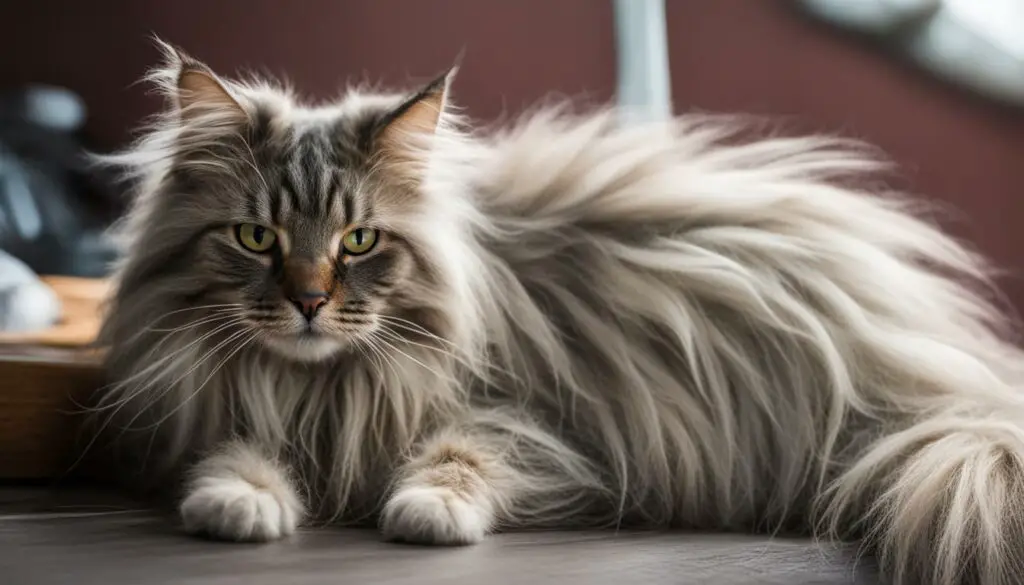Dealing with mats in your cat’s fur can be a challenge, but fear not! I’m here to provide you with the ultimate guide on how to remove mats from cats. Whether your furry friend has long or short hair, matting can cause discomfort and potential health issues. But with the right techniques and tools, you can make the mat removal process easier and painless for your cat.
Key Takeaways:
- Cat grooming is essential to prevent and remove mats from your cat’s fur.
- Use the right tools, such as a fine-toothed comb and slicker brush, for effective mat removal.
- Be patient and gentle when detangling mats from your cat’s fur.
- Consider seeking professional help if the mats are too difficult or if your cat shows aggressive behavior.
- Regular grooming and maintaining a healthy diet can help prevent future matting in your cat’s fur.
Why Do Cats Develop Mats?
Matting is a common issue in a cat’s fur and can cause discomfort and potential health problems. Understanding why mats develop is crucial in preventing them and ensuring your cat’s well-being. Cats can develop mats due to various factors, including shedding, moisture, and their activity level.
Shedding: Cats naturally shed their fur, and if the loose hairs are not regularly brushed out, they can become tangled and form mats. Long-haired cats are more prone to matting due to the increased amount of hair they shed.
Moisture: Cats that get wet, whether from rain or bathing, are more susceptible to matting. When the fur becomes damp, it clumps together and can quickly become tangled and matted.
Cat Activity: Cats that are highly active or engage in rough play may develop mats more easily. Their movements and interactions can cause the fur to tangle and form mats, especially in hard-to-reach areas like behind the ears or under the armpits.
To prevent mats from developing, regular grooming is essential. Brushing your cat’s fur daily, especially if they have a long coat, can remove loose hairs and prevent them from tangling. Ensuring a safe and comfortable grooming environment for your cat is also important, as stress or discomfort can contribute to mat formation.
| Factors Contributing to Matting | Prevention Tips |
|---|---|
| Shedding | Regular brushing to remove loose hairs |
| Moisture | Avoid letting your cat get excessively wet |
| Cat Activity | Monitor your cat’s interactions and provide regular grooming |
Regular grooming and understanding the factors that contribute to matting can help keep your cat’s fur in optimal condition. By addressing matting early on and taking preventative measures, you can ensure your cat remains comfortable, healthy, and mat-free.
Conclusion
Preventing mats in your cat’s fur requires regular grooming and attention to their specific needs. By understanding the reasons behind mat development and implementing preventative measures, you can keep your cat’s coat healthy and free of troublesome tangles. Remember to be patient and gentle during grooming sessions, and seek professional help if mats become too difficult to manage on your own.
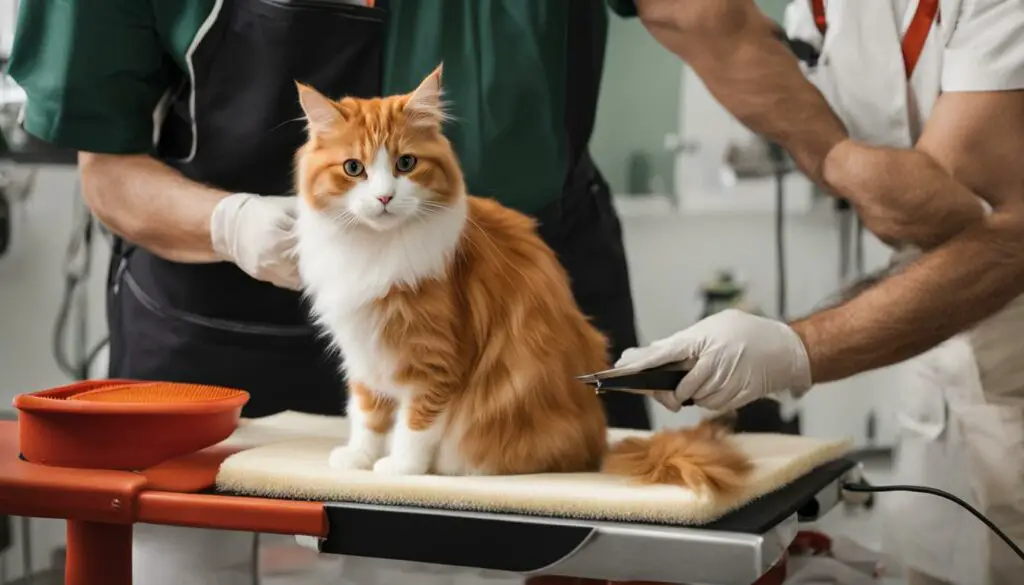
Tools for Mat Removal
When it comes to removing mats from your cat’s fur, having the right tools can make all the difference. Here are some essential cat grooming tools that will help you tackle those stubborn mats:
- Fine-toothed comb: This comb is designed to gently detangle the mats without causing discomfort to your cat. The fine teeth can easily separate the tangled hairs and make the removal process easier.
- Slicker brush: A slicker brush is great for removing loose hairs and tangles from your cat’s fur. It has fine, short wires that can penetrate through the outer layer of fur and reach the mats, making it easier to comb them out.
- Detangling spray: While optional, a detangling spray can be helpful in loosening the knots and making the mats easier to remove. Look for a cat-safe detangling spray that moisturizes the fur and reduces friction during combing.
- Cat treats: Treats can be a great way to reward your cat during the mat removal process. Offering treats before, during, and after grooming sessions can help keep your cat calm and cooperative, making the experience more pleasant for both of you.
With these tools in your grooming arsenal, you’ll be equipped to effectively remove mats from your cat’s fur without causing them any unnecessary stress or discomfort. Remember, patience and gentleness are key when handling mats, so take your time and work through them gradually.
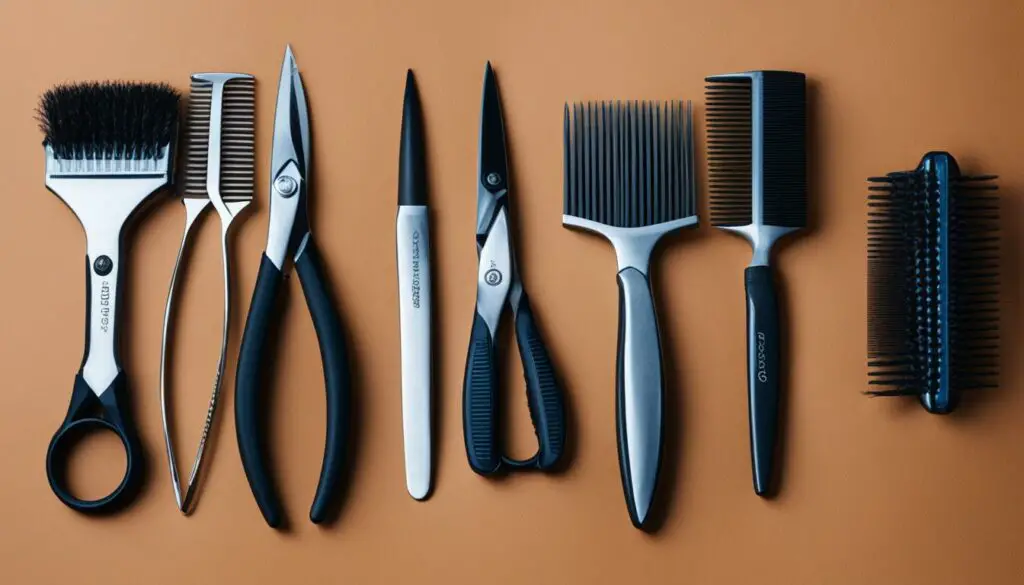
Table: Comparison of Cat Grooming Tools
| Tool | Description | Usage |
|---|---|---|
| Fine-toothed comb | A comb with closely spaced teeth, ideal for detangling mats and removing loose hairs. | Gently comb through the mats, starting from the edges and working your way towards the center. |
| Slicker brush | A brush with fine, short wires that can penetrate the fur and remove tangles and loose hairs. | Brush in the direction of hair growth, using short, gentle strokes to loosen the mats. |
| Detangling spray | A spray that helps to moisturize the fur and reduce friction, making it easier to comb out mats. | Spray a small amount onto the mats and gently work through them with the comb or brush. |
| Cat treats | Small, tasty rewards that can be given to your cat during grooming sessions to keep them calm and cooperative. | Offer treats before, during, and after grooming to reward and encourage positive behavior. |
By using these tools and techniques, you can help keep your cat’s fur mat-free and maintain their overall coat health.
Step-by-Step Guide for Painlessly Removing Mats
Gentle detangling, combing, and reward-based grooming are essential cat grooming techniques for painlessly removing mats from your feline friend’s fur. Follow these steps to ensure a stress-free experience for both you and your cat:
- Choose the right time: Find a moment when your cat is relaxed and calm. This could be after a nap or a meal when they are less likely to be agitated.
- Familiarize your cat with the grooming tools: Introduce your cat to the fine-toothed comb and slicker brush before starting the mat removal process. Let them sniff and investigate the tools to create a positive association.
- Gently detangle the mat: Begin by using your fingers to gently separate the hair in the mat. Be careful not to pull or tug on the fur, as this can cause discomfort. Once the hair starts to loosen, use a slicker brush to further detangle the mat.
- Use a fine-toothed comb: Once the mat is partially detangled, switch to a fine-toothed comb to work through any remaining knots. Start at the edges of the mat and slowly work your way towards the center, using gentle strokes.
- Reward your cat: After successfully removing a mat, reward your cat with treats and affection. This positive reinforcement helps create a pleasant association with grooming sessions.
Remember to be patient and take breaks if needed. If your cat becomes too stressed or agitated, it’s best to stop and try again later. It’s important to prioritize your cat’s comfort and well-being throughout the grooming process.
Common Challenges and Tips
While most mat removal sessions can go smoothly, you may encounter some challenges along the way. Here are a few common issues and tips on how to address them:
- Tight or stubborn mats: For mats that are particularly tight or stubborn, consider using a mat breaker tool. This specialized grooming tool is designed to gently cut through mats without hurting your cat’s skin.
- Aggressive behavior: If your cat displays aggressive behavior during grooming, it’s important to approach the situation with caution. Consult a professional cat groomer or veterinarian, who can provide guidance on handling aggression and may recommend behavior modification techniques.
- Professional help: If you’re unsure about how to safely remove a mat or if your cat has multiple difficult mats, it’s best to seek professional help from a cat groomer. They have the expertise to handle challenging grooming situations and can ensure the well-being of your cat.
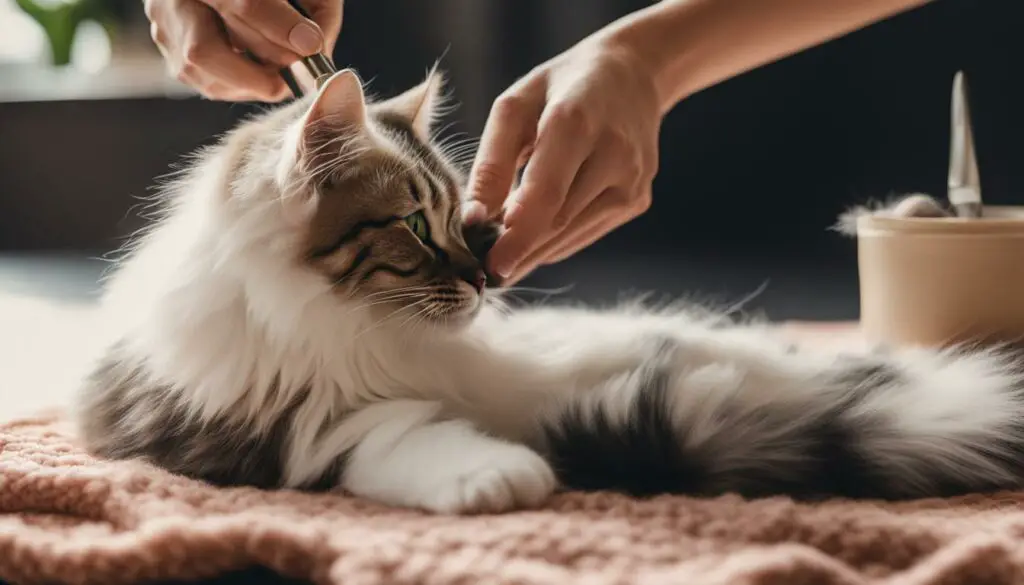
By following these gentle cat grooming techniques, you can make mat removal a positive experience for your cat. Remember to always prioritize your cat’s comfort and well-being, and don’t hesitate to seek professional help when needed.
When to Seek Professional Help
If you encounter difficult mats that are too challenging to remove or if you’re concerned about your cat’s skin condition, it may be time to seek professional help. A professional cat groomer or a veterinarian has the expertise and experience to safely handle these situations.
“Professional help is necessary when dealing with severe mats or when you’re unsure about your cat’s skin condition. They can provide the necessary guidance and ensure your cat’s well-being.”
Professional cat groomers are trained in handling difficult mats and can use specialized tools and techniques to remove them without causing harm to your cat. They will also assess your cat’s skin for any underlying issues that may have been hidden by the mats. In some cases, mats can lead to skin irritations or infections, which may require additional treatment from a veterinarian.
Don’t hesitate to reach out to a professional if you’re unsure or uncomfortable with removing mats yourself. Their expertise can make the process easier and safer for both you and your cat.
| When to Seek Professional Help | Why? |
|---|---|
| Your cat has large or severe mats | Professional groomers have the tools and techniques to handle difficult mats properly without harming your cat. |
| Your cat’s skin condition is a concern | Professional groomers can assess your cat’s skin for any underlying issues and provide appropriate treatment if needed. |
| You feel uncomfortable or unsure about removing mats | Seeking professional help ensures a safer and more successful mat removal process. |
Preventing Mats in Your Cat’s Fur
Regular grooming is essential for preventing mats in your cat’s fur. By incorporating a few simple practices into your cat’s grooming routine, you can keep their coat healthy and mat-free. Here are some key steps to follow:
1. Regular Brushing
One of the most effective ways to prevent mats is through regular brushing. Use a brush specifically designed for your cat’s hair type, such as a slicker brush for long-haired cats or a soft-bristle brush for short-haired cats. Brushing helps remove loose hairs and tangles before they have a chance to form mats. Aim to brush your cat at least once a week, increasing the frequency for long-haired breeds.
2. Pay Attention to the Undercoat
Don’t forget to brush the undercoat, especially for cats with long hair. The undercoat is prone to tangling and matting if not properly cared for. Use a wide-toothed comb or an undercoat rake to gently remove any loose hairs and prevent mats from forming.
3. Maintain a Healthy Diet and Nutrition
A healthy coat starts from within, so make sure your cat is getting proper nutrition. Feed them a balanced diet that includes essential fatty acids, such as omega-3, which helps keep their coat healthy and less prone to matting. Consult with your veterinarian to ensure your cat’s diet meets their specific nutritional needs.
4. Use the Right Cat Grooming Tools
Investing in the right grooming tools can make a significant difference in preventing mats. Choose tools such as a fine-toothed comb, slicker brush, or dematting tool that are suitable for your cat’s hair length and texture. Using the right tools ensures that you can effectively remove tangles and mats without causing discomfort to your cat.
By incorporating these preventive measures into your cat’s grooming routine, you can minimize the chances of mats forming in their fur. Regular brushing, paying attention to the undercoat, maintaining a healthy diet, and using the right grooming tools are key to keeping your cat’s coat mat-free and their skin healthy.
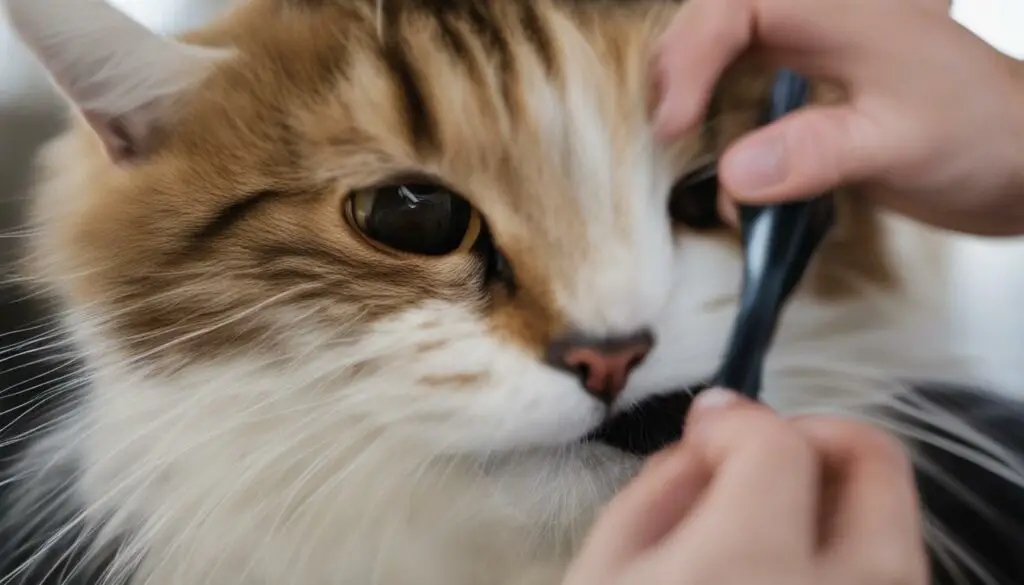
Tips for Successful Mat Removal
Successfully removing mats from your cat’s fur requires the right tools and techniques. Here are some tips to help you ensure a smooth and painless mat removal process:
1. Use a Mat Breaker Tool for Larger Mats
If your cat has larger mats that are difficult to detangle with a comb or brush, consider using a mat breaker tool. This specialized tool is designed to safely cut through mats without harming your cat’s skin. Be sure to use it carefully and follow the instructions provided.
2. Consult a Professional Cat Groomer if Needed
If you’re struggling to remove mats from your cat’s fur or if your cat becomes agitated or aggressive during the grooming process, it may be best to seek professional help. A professional cat groomer has the experience and expertise to safely remove mats and handle difficult grooming situations. Don’t hesitate to reach out for assistance if necessary.
3. Practice Proper Grooming Techniques
When removing mats, it’s important to use gentle and proper grooming techniques. Hold the mat close to the skin to avoid tugging or pulling on your cat’s fur. Use gentle strokes when combing or brushing to minimize discomfort. If you’re unsure about the correct techniques, you can find helpful grooming tutorials online or consult a professional groomer for guidance.
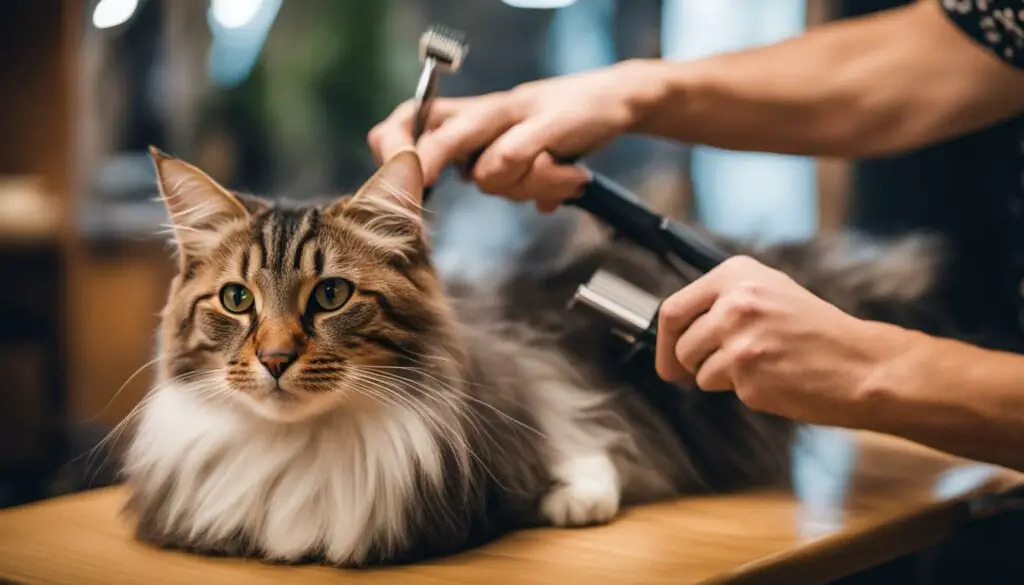
By following these tips, you can effectively remove mats from your cat’s fur and maintain their coat health. Remember to approach mat removal with patience and care to ensure your cat’s comfort throughout the process.
The Dangers of Cutting Mats with Scissors
When it comes to removing mats from your cat’s fur, it’s essential to approach the task with caution and care. One method that should be avoided is cutting the mats with scissors, especially if you lack experience. Using scissors can easily lead to accidental cuts on your cat’s delicate skin, causing injury and discomfort. The risks associated with scissor use make it crucial to seek professional help when dealing with mats that are too close to the skin.
Cats have thin and sensitive skin, making them susceptible to cuts and wounds. Attempting to cut mats yourself without proper training or expertise can lead to unintended harm to your feline friend. Professional groomers or veterinarians have the necessary skills and knowledge to safely remove mats without endangering your cat’s well-being. They have specialized tools and techniques to handle even the most challenging mats effectively.
If you encounter mats that are particularly difficult to remove or if you’re unsure about your ability to do it safely, it’s best to leave the task to the professionals. Don’t risk causing harm to your cat’s skin or making the matting situation worse. Seeking professional help ensures that the mat removal process is carried out with the utmost care and reduces the potential for injury or discomfort.
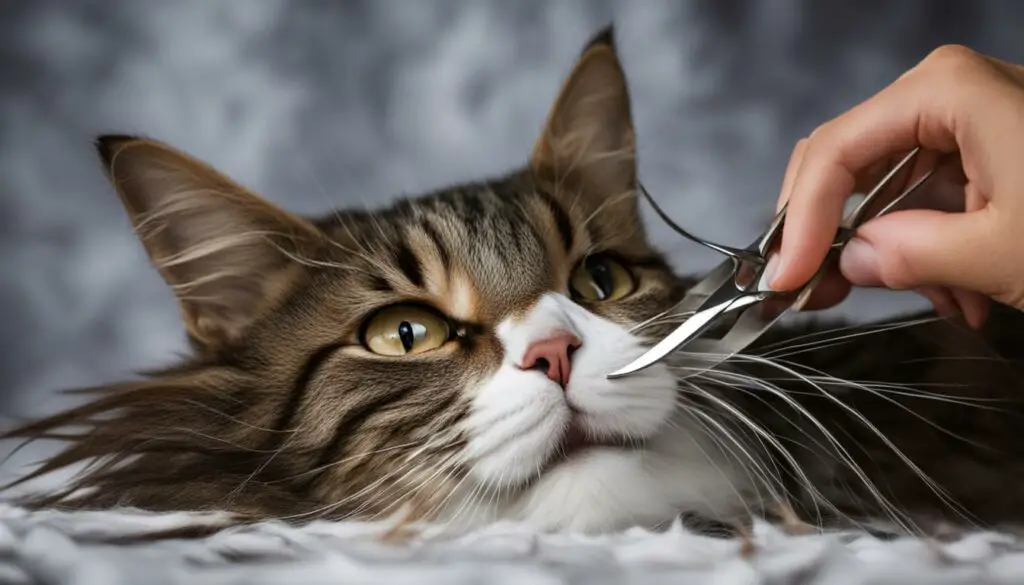
In conclusion, cutting mats with scissors should be avoided unless you have the necessary experience and skills. The potential risks of injuring your cat’s skin far outweigh the convenience of attempting a DIY approach. Instead, entrust the task of mat removal to professionals who can handle it safely and efficiently. Your cat’s well-being is of paramount importance, and seeking professional help for mat removal is the best way to ensure their health and comfort.
How Often to Groom Your Cat
Grooming your cat regularly is essential for maintaining their coat health and preventing mat formation. The frequency of grooming depends on your cat’s hair length and type.
Hair Length
Long-haired cats, such as Persians or Maine Coons, require more frequent grooming due to their dense and easily matted fur. It is recommended to brush them daily to remove loose hair and prevent mats from forming. Regular grooming sessions also help distribute natural oils throughout their coat, keeping it shiny and healthy.
On the other hand, short-haired cats, like Siamese or Burmese breeds, have less hair and are less prone to matting. Grooming short-haired cats a few times a week is generally sufficient to keep their coat in good condition. This frequency allows for the removal of any loose hair and prevents the formation of minor mats or knots.
Grooming Techniques
During each grooming session, make sure to thoroughly brush your cat’s fur from head to tail, paying extra attention to areas prone to matting, such as behind the ears and under the armpits. Use a suitable brush or comb for your cat’s hair type, ensuring it effectively detangles and removes loose hair without causing discomfort.
Remember to approach grooming sessions with patience and gentleness. Cats can be sensitive to grooming, so it’s important to create a calm and positive environment. Offering treats and praise throughout the grooming process can help your cat associate grooming with positive experiences.
By establishing a regular grooming routine that aligns with your cat’s hair length and type, you can effectively maintain their coat health, prevent mat formation, and ensure a comfortable and happy feline companion.
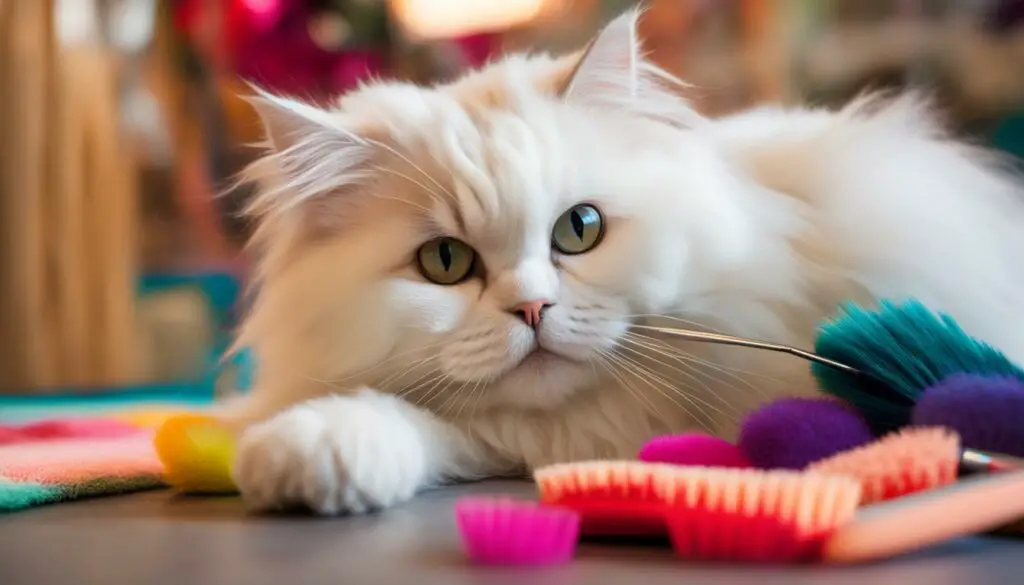
Can Baby Oil Be Used to Remove Mats?
When it comes to removing mats from your cat’s fur, it’s important to use the right products that are safe and effective. While some people may suggest using baby oil as a detangling agent, it is not recommended. Baby oil is not specifically formulated for cats and can potentially cause skin irritation or other adverse reactions. Instead, opt for cat grooming products such as detangling sprays or pet-safe conditioners, which are designed to work with your cat’s unique needs.
Detangling sprays are formulated to help loosen mats and make them easier to comb out. They typically contain ingredients that help to soften the hair and reduce friction, making the mat removal process smoother and more comfortable for your cat. Look for pet-safe options that are gentle on your cat’s skin and fur.
“Using the right cat grooming products, such as detangling sprays or pet-safe conditioners, can make the mat removal process easier and safer for your cat.”
Pet-safe conditioners can also be beneficial for mat removal. They can help to moisturize and nourish your cat’s fur, making it less prone to tangling and matting. Conditioners can also help to improve the overall health and appearance of your cat’s coat.
Benefits of Using Cat Grooming Products:
- Safe and gentle on your cat’s skin
- Help to loosen mats and tangles
- Moisturize and nourish the fur
- Improve the overall health and appearance of the coat
Remember, always consult with your veterinarian or a professional cat groomer if you have any concerns or questions about the best products to use for mat removal. They can provide you with expert advice tailored to your cat’s specific needs. By using the right cat grooming products, you can ensure a safe and effective mat removal process for your furry friend.
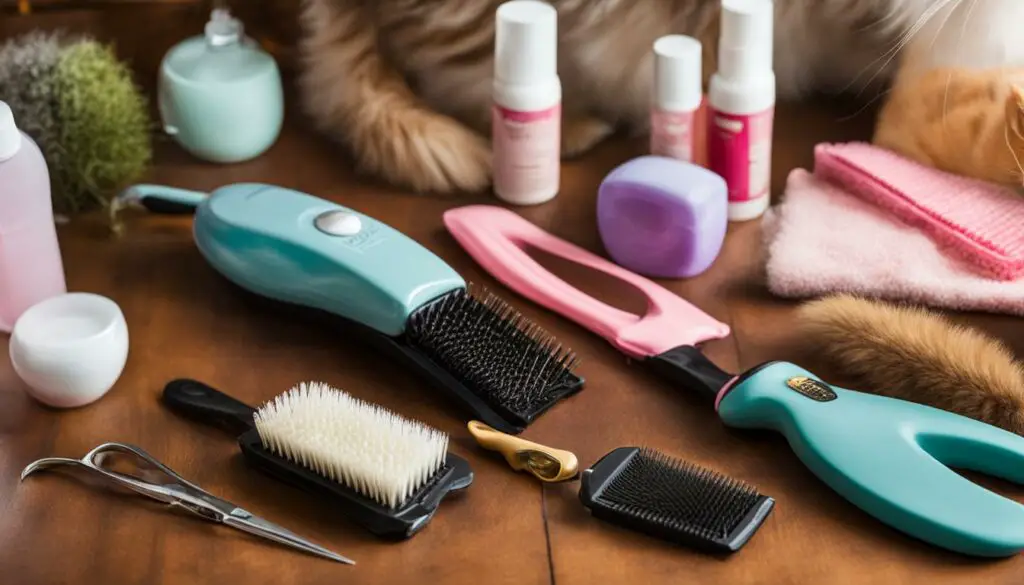
Dealing with Aggressive Behavior During Grooming
Grooming a cat can sometimes be a challenging experience, especially if your cat exhibits aggressive behavior during the process. It’s important to prioritize your cat’s safety and seek professional help if needed. The following tips can help you manage and modify your cat’s behavior during grooming:
Understanding the Causes
Aggressive behavior during grooming can be caused by various factors such as fear, anxiety, pain, or previous negative experiences. It’s essential to observe your cat’s body language and identify any triggers that may lead to aggression. By understanding the underlying causes, you can take steps towards addressing and resolving the issue.
Seeking Professional Help
If your cat’s aggressive behavior persists despite your best efforts, it may be wise to seek professional help. A professional cat groomer or veterinarian can provide guidance and techniques for handling aggressive behavior during grooming. They have the expertise to assess your cat’s specific needs and tailor a behavior modification plan accordingly.
Implementing Behavior Modification Techniques
Behavior modification techniques can help your cat associate grooming with positive experiences. These techniques may involve desensitization, counterconditioning, and reward-based training. By gradually introducing and rewarding your cat for calm behavior during grooming sessions, you can help them develop a more positive association with the process.
Grooming a cat with aggressive tendencies can be challenging, but with patience, professional guidance, and behavior modification techniques, it is possible to make the experience more manageable for both you and your feline friend.
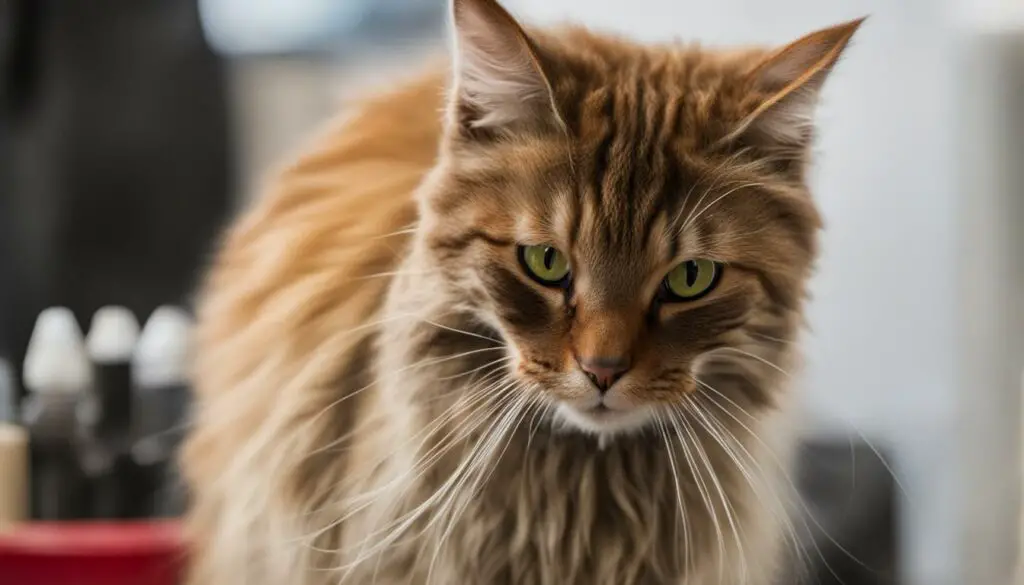
How Bathing Can Aid in Mat Removal
When it comes to removing mats from your cat’s fur, bathing can be a helpful step in the process. Bathing not only cleans your cat’s fur but also makes it smoother to comb through and remove mats. While not necessary for all cats, it can make the mat removal process easier and more effective.
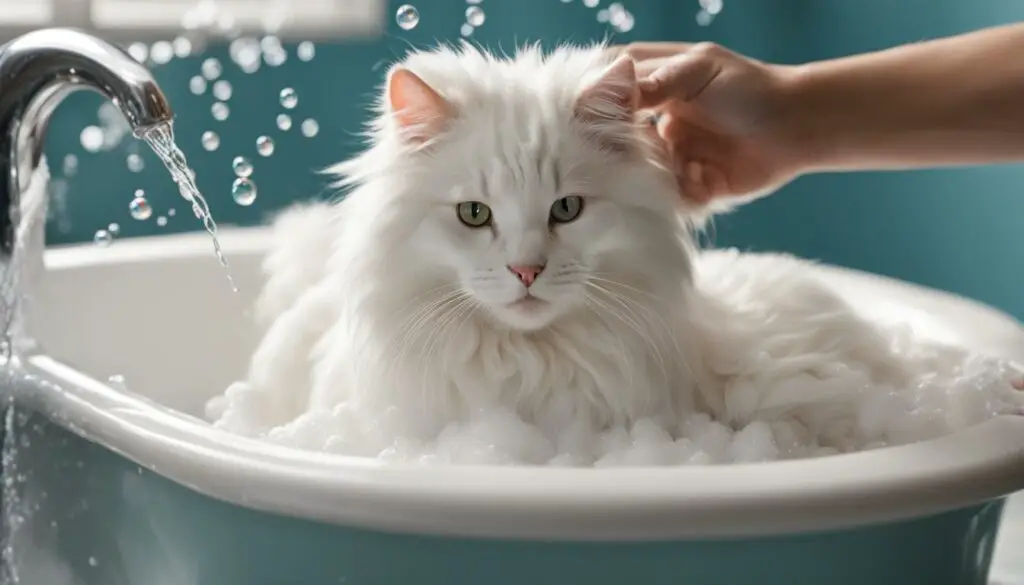
Before bathing your cat, make sure to gather all the necessary supplies, including cat-specific shampoo, a towel, and a non-slip mat for the bathtub or sink. It’s important to use a shampoo that is safe for cats and won’t irritate their skin. Wet your cat’s fur thoroughly, avoiding their face and ears, and lather them up with the shampoo. Rinse well to ensure all the shampoo is removed.
After bathing, gently towel dry your cat and comb through their fur with a fine-toothed comb. This will help remove any loose hairs and prevent mats from forming. It is important to note that some cats may not enjoy bathing, so it’s essential to approach this process with patience and respect for your cat’s comfort.
Benefits of bathing for mat prevention
- Bathing helps remove dirt, debris, and excess oils from your cat’s fur, preventing them from becoming trapped in the hair and leading to mat formation.
- Damp fur is less likely to tangle, making it easier to comb through and remove any existing mats.
- Regular bathing can promote a healthy coat by keeping the fur clean and well-maintained.
“Bathing your cat before mat removal can make the process easier by ensuring clean fur that is less likely to tangle.”
While bathing can be beneficial for mat removal, it is important to note that not all cats enjoy or tolerate baths. If your cat becomes stressed or aggressive during the bathing process, it may be best to explore alternative methods for mat removal or seek professional help. Always prioritize your cat’s comfort and well-being during grooming tasks.
| Bathing | Benefits |
|---|---|
| Promotes clean fur | Prevents mat formation |
| Helps to remove loose hairs | Makes mat removal easier |
The Importance of Post-Mat Removal Care
After successfully removing mats from your cat’s fur, it is crucial to provide proper care for their skin to ensure their overall health and well-being. Mats can cause various skin issues, including bald spots, skin irritations, and hot spots. By taking the necessary steps to support your cat’s skin health, you can prevent further discomfort and complications.
Cat Skin Health
Cat skin health is essential for their overall comfort and happiness. Mats can create tight knots that pull on the skin, leading to bald patches where the hair has been removed. These bald spots can be sensitive and prone to irritation. Additionally, mats can trap moisture against the skin, creating a warm and humid environment that is conducive to the development of hot spots and skin infections.
To promote cat skin health, gently examine your cat’s skin after mat removal. Look for any signs of redness, inflammation, or open wounds. If you notice any concerning issues, consult with a veterinarian for further evaluation and appropriate treatment. Regularly grooming your cat and preventing future mat formation can help maintain their skin health in the long run.
Caring for Bald Spots and Skin Irritations
If your cat has developed bald spots or skin irritations as a result of mats, it is important to provide special care for these areas. Keep the affected areas clean and dry to prevent further irritation or infection. Avoid using any harsh products or substances that could aggravate the skin. Instead, consult with a veterinarian for suitable topical treatments or recommendations for cat-friendly skincare products.
Preventing Hot Spots
Hot spots are painful and inflamed areas of the skin that can develop due to constant licking, scratching, or irritation. Mats can contribute to the formation of hot spots by trapping moisture and preventing proper airflow. To prevent hot spots, carefully groom your cat’s fur, paying close attention to areas prone to matting. Regularly check for signs of irritation and address any underlying causes, such as allergies or parasites, to minimize the risk of hot spot development.
By prioritizing post-mat removal care and ensuring your cat’s skin health, you can help them stay comfortable and prevent future mat-related issues. Remember to monitor their skin, seek veterinary assistance when necessary, and maintain a regular grooming routine to keep their coat and skin in optimal condition.
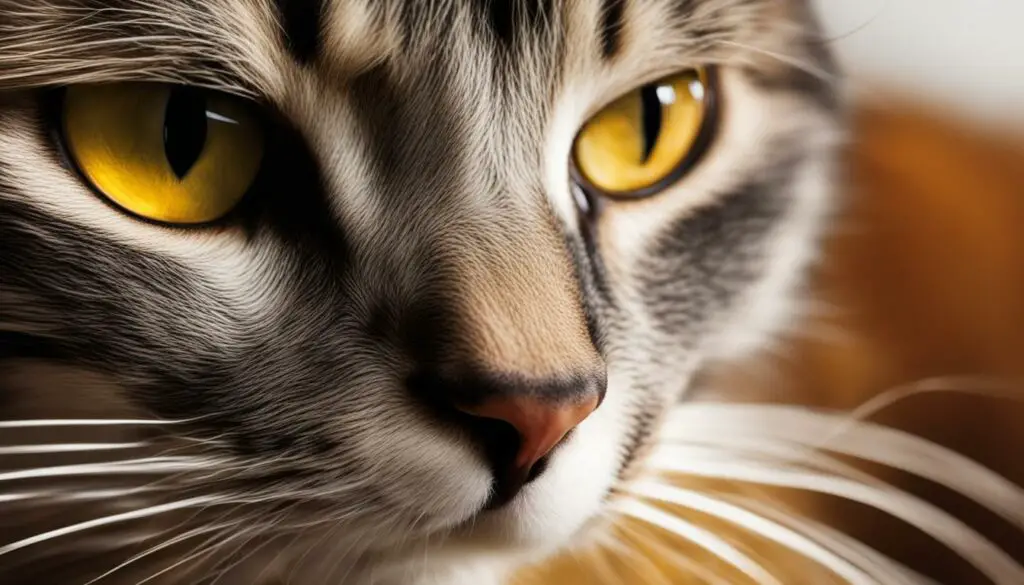
Conclusion
In conclusion, cat mat removal is an important aspect of a cat grooming routine for maintaining a healthy coat. Mats in a cat’s fur can cause discomfort and potential health issues, so it’s crucial to address them promptly and effectively.
By following the step-by-step guide provided in this article, you can safely and painlessly remove mats from your cat’s fur. Remember to choose the right time and use the appropriate tools, such as a fine-toothed comb and slicker brush. Positive reinforcement, such as treats and affection, can also help make the grooming experience more pleasant for your cat.
Preventing mats in your cat’s fur is equally important. Regular grooming, including daily brushing and attention to the undercoat, can help minimize mat formation. Additionally, ensuring your cat has a healthy diet and using the right cat grooming tools for their specific hair type can help prevent mats from occurring.
By prioritizing cat mat removal and maintaining a consistent grooming routine, you can keep your cat’s coat healthy, free of mats, and provide them with the comfort they deserve.
FAQ
Why do cats develop mats?
Cats can develop mats in their fur due to factors such as shedding, moisture, and their activity level.
What tools do I need for mat removal?
You will need a fine-toothed comb, a slicker brush, and detangling spray (optional but helpful) for mat removal.
How do I painlessly remove mats from my cat’s fur?
Follow these steps: choose the right time when your cat is relaxed, familiarize your cat with the grooming tools, gently detangle the mat with your fingers and a slicker brush, use a fine-toothed comb to further detangle the mat, and reward your cat with treats and affection after successful mat removal.
When should I seek professional help for mat removal?
If your cat has large or severe mats, it may be best to seek professional help from a cat groomer or veterinarian.
How can I prevent mats in my cat’s fur?
Regular grooming, brushing your cat daily, ensuring a healthy diet, and using the right cat grooming tools can help prevent mats from forming.
What are some additional tips for successful mat removal?
Consider using a mat breaker tool, consult a professional cat groomer if you’re struggling, and practice proper grooming techniques like holding the mat close to the skin and using gentle strokes.
Is it safe to cut mats with scissors?
It is not recommended to cut mats with scissors unless you are experienced. Scissors can easily cut your cat’s skin, leading to injury and discomfort. Seek professional help if a mat is too close to the skin.
How often should I groom my cat?
The frequency of grooming depends on your cat’s coat type. Long-haired cats may require daily brushing, while short-haired cats only need grooming a few times a week.
Can I use baby oil to remove mats from my cat’s fur?
It is not recommended to use baby oil or any human products on your cat’s fur. Opt for pet-safe detangling sprays or conditioners specifically designed for cats.
What should I do if my cat becomes aggressive during grooming?
Prioritize safety and consult a professional groomer or veterinarian for guidance. They can provide strategies for handling aggressive behavior and may recommend behavior modification techniques.
Can bathing help with mat removal?
Bathing your cat before mat removal can make the process easier, but if your cat is not comfortable with baths, you can still remove mats without bathing.
How important is post-mat removal care?
After removing mats, it is important to care for your cat’s skin. Monitor any bald spots or skin irritations and consult a veterinarian if necessary.

